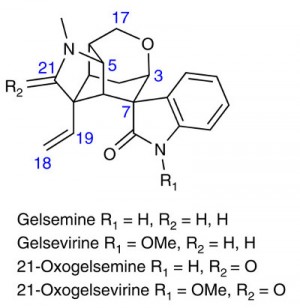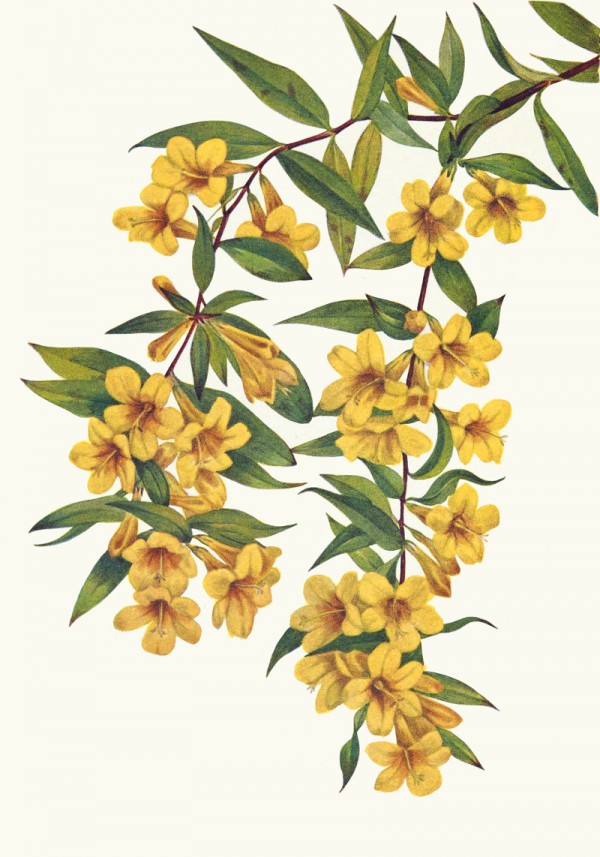Gelsemium sempervirens (L.) J. St.-Hil. - syn.Bignonia sempervirens L. - Gelsemiaceae (Loganiaceae)
yellow jessamine, evening trumpet flower, Carolina jasmine, Carolina-Jasmin, Giftjasmin
Evergreen vine, native to southern North America and Central America (Virginia to Honduras), cultivated as ornamental; leaves lanceolate, shiny; flowers solitary or in axillary clusters, funnel-shaped, yellow, fragrant, up to 4cm long; fruit a capsule.
http://www.missouribotanicalgarden.org/PlantFinder/PlantFinderDetails.aspx?kempercode=c519
„While Arthur Conan Doyle is most commonly known as the mastermind behind Sherlock Holmes, he also was a doctor with a similar madness to that of Sherlock’s. Doyle’s first academic publication was concerning the effects of Gelsemium intoxication in humans. After observing the successful treatment of a gelsemium tincture for neuralgia, he became determined to “ascertain how far one might go in taking the drug, and what the primary symptoms of an overdose might be.” To do this, Doyle ingested increasing doses of his prepared tincture every day and published his results in the British Medical Journal. He determined that an adult could safely ingest up to 90 minims of the gelsemium tincture (1 minim = 1/480 fluid ounces).“ https://en.wikipedia.org/wiki/Gelsemine [Gelseminum as a poison., Conan Doyle, A., BMJ (1879)]
All plant parts contain toxic monoterpene indole alkaloids. Neurological signs of intoxication in animals are characterized by marked progressive weakness and muscle spasms (caused by the loss of muscle control) culminating in death.
„Histologic lesions included mild diffuse neuronal degeneration and cerebellar Purkinje cell loss in all animals with mild multifocal vacuolation of brainstem and cerebral white matter in 1 goat, and myofiber atrophy with perimyseal fibrosis in the goose.“
[Multiple animal intoxications associated with Carolina jessamine (Gelsemium sempervirens) ingestions., Thompson, L.J., Frazier, K., Stiver, S., Styer, E., Veterinary and human toxicology, 44(5), 2002, 272-273]
Rhizomes and roots (Gelsemii rhizoma) or its extracted alkloids are formerly used to treat neuralgia, especially of the face and the mouth. „It has been used in cough syrups (to treat whooping cough and asthma) and externally to treat various pains resulting from pressure on a nerve, especially in the spinal cord. It is claimed to be of use against migraine and neurological disorders and bleeding (haemorrhoids and the uters)… The alkaloids (especially gelsemine) inhibit acetylcholine receptors (especially muscarinic AChR), acetylcholine esterase and the synaptic re-uptake of dopamin, noradrenaline and serotonine. These properties explain the observed antispasmodic, analgesic, hypotonic and sedative activities.“
[Medicinal Plants of the World. Ben-Erik Van Wyk and Michael Wink, Pretoria 2004, 155]
„Gelsemium sempervirens is an obligate outcrosser and secretes the commercially available alkaloid gelsemine in floral nectar. … Bumblebee choice behaviour was significantly influenced by the level of gelsemine in the nectar of available flower types. Although bees as a group readily collected floral nectar containing gelsemine on monotypic arrays during training, they had a strong preference for nectar with equal sucrose rewards but no gelsemine or lower levels of gelsemine on mixed arrays. Bees showed no overall nectar preference when the sucrose concentration of nectar with alkaloids was increased relative to an alkaloid-free nectar alternative.“
[Ecological context influences pollinator deterrence by alkaloids in floral nectar., Gegear, R.J., Manson, J.S., Thomson, J.D., Ecology Letters, 10(5), 2007, 375-382] http://labs.eeb.utoronto.ca/thomson/publications/Gegear%20et%20al.%20pollinator%20deterrence%20alkaloids%202007%20Ecology%20Letters.pdf
„Centesimal (C) dilutions of G. sempervirens (4C,5C,7C,9C, and 30C) appeared able to change significantly mouse behavioral effects as assessed in the open-field (OF) and light–dark (LD) tests in blind and randomized fashion (Magnani et al., 2010) but effects in the elevated plus-maze, an assay considered to be important in behavioral assessment of potential anxiolytic compounds (Ramos, 2008), have not been assessed…
The main active substance in G. sempervirens causing an anxiolytic action is believed to be gelsemine (Bellavite, et al.,2009). Gelsemine, is an alkaloid that contains the same functional groups as strychnine and has been shown to increase 3α,5α-tetrahydroprogesterone or allopregnenolone (3α,5α-THP) neurosteroid synthesis (Venard et al., 2008). The stimulatory effects of glycine and gelsemine on 3α,5α-THP production were additive when the two drugs were combined. These results may suggest that glycine and gelsemine, acting via glycine receptor (Gly-R), upregulate 3α,5α-THP biosynthesis in the spinal cord (Venard et al., 2008)…
As several complex issues were raised, the use of Gelsemium in behavioral science should undergo some reappraisal. In this field, a possible main critical topic might be the placebo/nocebo response of animals, able to exert biases on anxiety models.“
[Gelsemine and Gelsemium sempervirens L. extracts in animal behavioral test: comments and related biases., Magnani, P., Conforti, A., Zanolin, E., Marzotto, M., Bellavite, P., Psychopharmacology (Berl.), 210, 2011, 533-545]
 | some gelsemium alkaloids [Chen, X., Duan, S., Tao, C., Zhai, H., & Qiu, F. G. (2015). Total synthesis of (+)-gelsemine via an organocatalytic Diels-Alder approach. Nature communications, 6.] http://www.nature.com/ncomms/2015/150521/ncomms8204/full/ncomms8204.html |

Walcott, Mary Vaux, North American wild flowers, vol.3 t.220 (1925-1927)
http://plantgenera.org/species.php?id_species=456851
